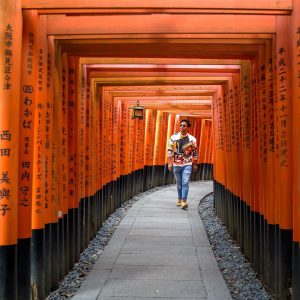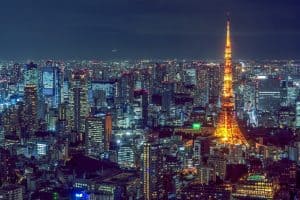Japan Travel Guide For Backpackers & Digital Nomads
This Asian country is a perfect blend of modernism and ancient traditions. From high tech technological development to ancient praying temples, high skyscrapers to natural soothing forests, amazing nightlife to calm star sighting nights, you will find everything in this beautiful country. They have the most polite people in the world, an efficient public transport system, and of course, incredible food.
Japan might look like a bit small on the map but the country is so rich with wonders and amazing spots that it will be difficult for you to sort out what should and should not be avoided because you can’t take it all in, in just one visit.
To help you with that, I have listed some amazing spots in the region to make it easier for you to plan your trip.
Table of Contents
My Japan Story
Japan at a Glace
Japanese
Japanese yen
World Currency Shop
Sushi
Yes
NTT Docomo and KDDI
Yes
Check CDC
A and B
Uber & JapanTaxi
June and July
+81
Yes
Yes
Yes
Cash
December- February
110
Looking For Friends Or Have Questions? Check our whatsapp chats , Dont see a group? Check “More Travel Whatsapp Groups‘
Related Posts

Top 10 Instagrammable Spots In Kyoto, Japan
This article will guide you through the top Instagrammable spots in Kyoto, Japan. Don’t miss out photograping these beautiful places in Kyoto.

The Most Instagrammable Spots in Tokyo: 8 Cool Locations (Updated 2024)
This article will guide you through the top best Instagrammable places in Tokyo Japan. Trust me; you don’t want to miss out on some of these! So, without waiting any longer, let’s dive right in!

Can I Apply for a Digital Nomad Visa in Japan? Here’s 5 Top Things to Know
How to application guide for for a Bahamas Digital Nomad Visa. The Visa Application Process: Documentation, Financial Requirements, Work Requirements and More.
Japan Visa Requirements
Citizens of most European countries, the United States, Australia, and Argentina do not need to apply for a tourist visa since they are visa-free countries for tourism purposes. Nationals from any of those regions can stay in Japan for a maximum of 90 days visa-free and are assigned Temporary Visitor status.
On the other hand, Japan requires a visa application for nationalities from:
- China
- Russia
- Philippines
- Vietnam
- CIS countries pricier
- Georgia
The requirements for a visa application can be tedious. These are to be submitted to your Japanese embassy or approved travel agencies:
- Valid passport with at least 6 months remaining
- A filled-out visa application form (Link: Japan Visa Application)
- Recent colored passport photo
- A certified copy of your birth certificate (if married, also submit a marriage certificate)
- Proof of financial ability
- Bank certificate (at least 6 months)
- Submit an income tax return if applying without a sponsor
- A copy of your Certificate of Employment
- Complete travel itinerary
Top 5 Things to See and Do in Japan
1. Kyoto
2. Mt Fuji
3. Tokyo National-Museum
4. Tsukiji Fish Market
5. Maruyama Park
Other Things to See and Do in Japan
You may wonder how long your trip should be. Depending on your budget, I reccomend 2 – 4 weeks, check out this japan itinerary for a better idea.
1. Tokyo
This bustling capital is a perfect blend of tradition and ultra-modernism. Meiji Shino Shrine, Imperial Palace, and Tokyo National Museum are some of the historical must-see places. Witness the morning auctions of the Toyosu fish market, live in the moment with vibrant nightlife, drink in the karaoke bars and get an amazing view of the whole city from the public reservation deck of Tokyo SkyTree Tower. Also add Shibuya Crossing, DisneySea and Tokyo Metropolitan Government Building in your list.
2. Osaka
Here lies the 16th century Osaka Castle that has undergone restoration numerous times, surrounded by a beautiful park, and Sumiyoshi-Taisha, one of the oldest Shinto Shrine of Japan. Visit Neon-lit Dōtonbori that is full of eateries with shapes of sea creatures as their signs; trendy boutiques in Shinsaibashi’s; Universal Studios of Japan; Osaka Aquarium Kaiyukan; Nara Deer Park and the famous Tempozan Ferris Wheel to get a sweeping view of the Osaka Bay.
3. Yokohama
TThe ancient city is home to various amazing museums like the Yokohama Museum of Art, Yokohama Port Museum, Mitsubishi Minatomirai Industrial Museum, Raumen and Cupnoodles Museum, etc. The city is mainly famous for the Sankei-en Garden, a large China Town with various Chinese shops and restaurants, and the majestic Landmark Tower skyscraper, the second largest building in Japan.
4. Nikko
This temple town is a UNESCO world heritage site and is famous for the shrines and temples with their ancient outlooks. Visit the famous Toshogu Shrine, hike up to the calming Takino shrine, Taiyuan Temple, and the Rinnoji. Spend a day or two to discover the magic of all the peaceful sites in the woods. Explore the Shin-kyō Bridge and its beautiful park filled with amazing waterfalls, lakes, mountains, hiking trails, and cute monkeys. Eat a Dango from some street stall or sushi from Komekichi Kozushi.
5. Hiroshima’s Peace Memorial Park and Museum
World’s first city to be bombarded with the atomic bomb, in 1945, is one of the major attraction points in Japan. The Hiroshima Peace Memorial Park and Museum commemorate the innocent victims of the traumatic event. Explore the rebuilt modern city and visit the beautiful Shukkei-en garden, and Hiroshima Castle, surrounded by a moat and an amazing park.
6. Arashyama
A pleasant district in the western outskirts of Kyoto is famous mainly for the Arashiyama Bamboo Grove. The Surrounding area has many magnificent sights and temples like the sprawling Tenryu-Ji Temple, Nison-in Temple, Jojako-Ji Temple, Gio-Ji Temple, and Adashino-Nembutsu-Ji Temple. Rent a boat and row around to explore the beauty of the area. Katsura Rikyu Imperial Villa and Okochi-Sanso Villa are imperial architectural properties.
7. The Island Shrine of Itsukushima
Miyajima Island is home to the most popular Itsukushima Shrine. The shrine is famous mainly because of its floating O-Torii gate built on water that appears to be floating on water, especially during high tide. The shrine complex consists of various beautiful structures like main Hall, Prayer Hall, Offerings Hall and a Noh Theater stage connected through walkways and bridges, supported by pillars over the sea
8. Niseko
This beautiful town is located near Mt. Yotei, the dormant volcano of Hokkaido Island. Home to various ski centers it is surrounded by amazing snow capped mountains. The area is home to many golf courses as well as the amazing white-water Shiribetsu River. In the surrounding are various mountains with hot spring resorts called onsen.
9. Nara
The old capital city of Japan has various artworks and temples back from the 8th century. The major attraction in the city is the Nara Park of the Todai temple. A 15m high bronze statue of Buddha named Daibutsu is displayed in the wooden hall for the temple. The park is also home to Shinto Shrine Kasuga Taisha, Kofuku-Ji temple and Yakushi-Ji Temple. Also, visit the Nara National Museum which has various Buddhist art and archeological objects.
10. Shikoku
The island is the smallest major island of Japan and is mainly famous due to being encircled by the 1,200 km route of 88-temple Buddhist pilgrimage. Apart from the pilgrimage route and temples, the island has various other tourist attractions, like the hot-spring spas of Dogo Onsen, Matsuyama Castle, Tsurugisan Quasi-National Park, etc.
Typical Costs

Transportation
If you are going to travel by train or bus, get a pass. JR passes for train travel are available for 7, 14 or 21 consecutive days in $267, $426 and $545 respectively. Getting a pass will save you lots of money. Regular one side train tickets between two places may range between $37 to $256 depending on the destination. Bus tickets may also vary according to destination. A 2 hours ride may cost almost $11 while a 9 hour journey may cost you $50 . Airplane tickets are almost 8 times more expensive than trains or buses.

Accommodation
If you are on a budget go for a hostel dorm room that you can get for about $15-$25 per night. Double rooms have higher prices i.e. $60-$80 per night, in a hostel, guest room or budget hotel. If you want more luxurious rooms, the price will rise higher. If you are looking for more traditional accommodation, the ryokan is a good choice but is fairly expensive, starting from $120 per night.

Food
As long as you are avoiding fancy and western restaurants, you will save loads of money. Get some street snacks like takoyaki for $4.5, or a bowl of ramen noodles or soba noodles for $2-$9. You can even get good sushi for about $6-$18. Restaurant meals will be for about $20 and mid range restaurants for $40 per meal.

Activities
A lot of activities in Japan are free. Visiting parks and shopping areas are a huge plus. There are many free performances and parades, especially in summer time.
Cost Of Living
Accommodation: Airbnb rentals, capsule hotels, and hostels cost around $15 to $25 per night. The monthly rent for an apartment in Tokyo is at least USD 500, depending on the location and size of the apartment.
Transportation: A one-way ticket on the Tokyo Metro costs around $2–3. But you can buy a 21-day unlimited-ride JR Pass (which includes the majority of train lines and JR buses) for about $500. Home cooking will cost about $200-$300 per person for a month’s worth of groceries.
Suggested Budget
The average daily cost, if you remain cautious about spending, will be around $65-$75. With a fancier holiday, your budget will rise to about $100 per day. But if you choose to spend your holiday luxuriously, prepare an estimate of more than $200.
Budgeting Tips
As always here are some tips to saving you some money.
1. Book In Advance
Things get pricey really quickly, so book all your accommodation and excursions ahead of time.2. Travel
Use the Train passes you will have hundreds of dollars by doing so.3. Go in the off Season
To save some money from housing go in the off season i.e. February, March, September, and October is when there are less tourists and you can get a hotel room at almost half price compared to peak season.4. Free Festivals and events
Keep an eye for free festivals and tourist destinations. You can always ask for some help from your hostel or just search online for upcoming festivals or must-see destinations around your location.5. Food
Avoid the tourist hang-out spots because the food could be expensive. You will get a huge variety of cheap pre-packed meals at 7-Eleven, that is popular even among locals.Food In Japan
Coming Soon
Best Cities in Japan for Digital Nomads
- Tokyo
Tokyo is the capital city of Japan and a thriving economic city that offers many job opportunities in various industries. While it is a hyper-modernized city, known for its technology, fashion, and entertainment industries, Tokyo is still a cultural hub, with ancient shrines, temples, and everything related to Japan’s traditions and beliefs. A great city to start your Japan adventure.
- Kyoto
Kyoto is a city with a rich cultural heritage, featuring many historic temples, shrines, and gardens. Also home to the majority of traditional crafts and industries. It is a great place for nomads who want to experience the traditional side of Japan while still enjoying the modern conveniences of city life.
- Osaka
Osaka, the food capital of Japan. They have it all in here: veggies, meat, seafood, you name it. It can also quite compare to Tokyo in terms of hustle and bustle. So aside for foodies, those who love the nightlife should put Osaka on their options!
- Sapporo
Up for some chilly time? Known for its snow festivals, ski resorts, and outdoor activities, Sapporo is one of the best places in all of Asia if you want to experience such weather.
Where To Stay
Here is a list of places I have stayed, I was happy with my stays here!
Kyoto
Osaka
Murayama
MT Fuji
TBD
Tokyo
TBD
Other
TBD
Nomad Networking
Finding groups of expats and nomads in Japan is not hard, especially if you are staying in the cities. You will find foreigners in local coffee shops, co-working spaces, or even just strolling about on the streets. And most of them are glad to talk to someone they can easily converse with (yep, English speakers are scarce)
Aside from that, here are some groups you can join before even arriving in Japan. Lots of tips and guides are available as well to help with your journey.
- Tokyo Expat Network Facebook Group – A private Facebook group with tons of members that shares inputs, guides, and real-time forums with those in chat.
- Destination Japan – A public Facebook group for both nomads and travelers heading to Japan.
- Amigo International Group – International group and language party events for Japanese and foreigners.
- Japan International Events + Friends – Offers a range of exciting events and trips for you to experience.
Nomad Coworking And Working Spots
You cant be a digital nomad without wifi. So below are some spots where one can work comfortably. Dont forget to check my nomad lunch break section for places you can still visit and/or work from during lunch. #nomadworkspace
Tsukiji Fish Market
Nomad Lunch Breaks
Balancing work and exploring can be tough, here are some activities or places you can visit during a lunch hour. You will see the words hotspot, wifi, or break which indicates what you can use to work there, or if you cant and its time for a work break. #nomadlunchbreak
Kyoto
TBD
Osaka
TBD
Murayama
TBD
MT Fuji
TBD
Tokyo
TBD
Other
TBD
Wifi And Internet In The Japan
Internet and Wifi Accessibility Internet and WiFi accessibility in Japan is generally good, especially in large cities like Tokyo and Kyoto. Many cafes, hotel lobbies, and even public places offer free wifi, although the quality and speed may vary. Other than that, Japan has invested much in providing stable fixed Internet connections. So your private Wifi or LAN connections in hotels, Airbnbs, and co-working spaces should be flawless.
However, digital nomads in Japan may require more reliable and consistent internet access for activities such as work or video streaming, which may be difficult to achieve while on the go or with free wifi alone. In these cases, renting a pocket WiFi device or a SIM card is recommended to ensure fast and reliable internet access throughout your trip.
How To Get Around Japan

Car Rentals
With such a comfortable public transport system, I wouldn’t recommend renting a car. Road signs are in Japanese, difficult to understand and expensive highway tolls make driving a bad option.

RideSharing
Taxis are crazy expensive here in my opinion, I would say not to use them unless necessary.

Trains
Japan has a well-formed and maintained a network of fast non-stop bullet trains as well as traditional express trains. Bullet trains travel faster but the regular express trains are also convenient to travel around the region. Fares may vary depending upon the destinations. You can get a JR pass to travel more cheaply.

Bus
The bus transport system is also good and cheaper than the trains but is comparatively slower. Buses are good to travel to destinations inaccessible through trains.

Airlines
The fastest way to travel around is also the most expensive one. If you are very short on time only then you should go for a flight. Otherwise, there are cheaper ways to travel around the country.

Hitch Hiking
Though the four main islands are connected through tunnels and bridges but smaller islands are preferably accessed through ferries. Get a ferries’ pass if you have no problem traveling in second-class, and travel in comparatively less amount.

Resources
When To Go



Japan is a country of all four seasons. The best time to visit is during spring i.e. March to May and autumn i.e. September to November, when there is less rainfall with a mild temperature, and skies are almost clear most of the time. Wintertime, November to February, is less appealing for most people except for those who love snow sports like skiing, and onsen. If you do go during winter, check out this japan winter guide on suggested places to visit . Due to less tourists, you will get everything for comparatively less cost. June to August is summer, hot and humid but is considered to be suitable for activities like hiking. May to October is a high-risk time for typhoons so be careful if you go in that time.
Pros And Cons Of Living As A Digital Nomad In Japan
Pros:
- Generally safe and has a low crime rate
- High-quality infrastructure and public transportation
- Rich cultural experiences
- Delicious food and unique culinary culture
- Clean and well-maintained cities and public spaces
- Opportunities for career advancement and high-paying jobs in certain industries
- Access to advanced technology and innovative products
Cons:
- High cost of living, especially in major cities like Tokyo
- The majority is written in Japanese which can make it difficult to navigate everyday life
- Language-barrier is prevalent, most locals steer away if approached in English
- Conformity and strict social norms can be a challenge to some
- Difficulty in building meaningful relationships with locals
- Harsh working culture and long hours in certain industries
- Natural disasters are common such as earthquakes and typhoons
Common Questions About Japan
Yes, credit cards are generally accepted in Japan but I advise you to still have some cash (in Japanese Yen) for purchases in small amounts or in case of any issues with your card.
Japan is generally safe for anyone, as it has a very low crime rate. But earthquakes and torrential rains can be frequent. So reading about those situations and being vigilant as you are in an unfamiliar place is still much advised.
How To Stay Safe and Aware of Scams
Ranked as 9th out of 191 countries in The Global Peace Index (2018), Japan is a safe country compared to numerous others. The crime rate is minimal, but you still need to be careful about your safety.
1. Documents and Cash
Keep extra copies of your documents like passport. Don’t put your cash together in one place, rather in different pockets, in the bag, under belt wallet, etc.2. Taxis
Keep your eyes open and trust your instinct. If you are feeling something shady about the taxi driver just stop and get out.3. Follow Japanese Rules
Try to follow the Japanese ethics as much as you can and be respectful to the people.4. Medical Insurance
Get medical insurance. Medical facilities are abundant in Japan but are highly expensive.5. Drugs
Avoid drugs completely because they are strictly prohibited and illegal. Finding drugs may get you in contact with some shady mafia people. Be careful in the bars, especially at night, drink spiking is quite common.Packing List
What to pack
Depending on the length of your stay your list may be a little different but here is a small outline of what items you may want to pack.

2 Pairs of Shorts

1 long sleeve

7 pairs of underwear

Medicine: Tums, Aspirin, Pepto , Antibacterial Cream, Hydro cortisone cream

2 Pair of jeans

Flip flops

Toiletries

Locks

Swim Trunks

Comfortable Sneakers

Quick dry towel

Laundry Bag

5 shirts

7 pairs of socks

Dedorant (Its hot)

Hand Sanitizer

Power Bank

Universal Adapter

Sun Glasses

Sun Screen

Umbrella
